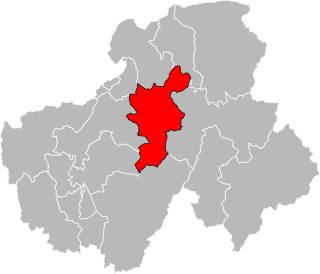
Savoy is a cultural-historical region in the Western Alps. Situated on the cultural boundary between Occitania and Piedmont, the area extends from Lake Geneva in the north to the Dauphiné in the south and west and to the Aosta Valley in the east.

Amadeus V, also known as Amadeus the Great, was the Count of Savoy from 1285 until his death in 1323. He was a significant medieval ruler who played a crucial role in the expansion and consolidation of the House of Savoy’s influence in the regions that are now part of modern-day France, Italy, and Switzerland.

Haute-Savoie is a department in the Auvergne-Rhône-Alpes region of Southeastern France, bordering both Switzerland and Italy. Its prefecture is Annecy. To the north is Lake Geneva; to the south and southeast are Mont Blanc and the Aravis mountain range.

The Dauphiné, formerly known in English as Dauphiny, is a former province in southeastern France, whose area roughly corresponded to that of the present departments of Isère, Drôme and Hautes-Alpes. The Dauphiné was originally the Dauphiné of Viennois.

Annemasse is a commune in the Haute-Savoie department in the Auvergne-Rhône-Alpes region in Eastern France. Even though it covers a relatively small territory, it is Haute-Savoie's second most populous commune after the prefecture Annecy, with 36,250 residents as of 2018.

Thonon-les-Bains, often simply referred to as Thonon, is a subprefecture of the Haute-Savoie department in the Auvergne-Rhône-Alpes region in Eastern France. In 2018, the commune had a population of 35,241. Thonon-les-Bains is part of a transborder metropolitan area known as Grand Genève. It is situated on the shores of Lake Geneva.

Ville-la-Grand is a commune in the Haute-Savoie department in the Auvergne-Rhône-Alpes region in south-eastern France. The commune consists of the main town Ville-la-Grand and the small villages Crêt and Marsaz.

Cluses is a commune in the Haute-Savoie department in the Auvergne-Rhône-Alpes region in southeastern France.

Sallanches is a commune in the Haute-Savoie department of the Auvergne-Rhône-Alpes region of France. Located close to the Mont Blanc massif, many visitors pass through the town en route to well-known alpine resorts such as Chamonix, Megève and Saint-Gervais-les-Bains. In 2018, the commune had a population of 16,508, and its urban area had 46,128 inhabitants.
The Arve Valley is an alpine valley located in the French Haute-Savoie department. The namesake of the valley is the river at the bottom: the Arve. The valley as a whole makes up the majority of Faucigny, one of the Natural Regions of France, and one of six that make up the Savoie region.

Saint-Pierre-en-Faucigny is a commune in the Haute-Savoie department in the Auvergne-Rhône-Alpes region in Eastern France.

Étrembières is a commune in the Haute-Savoie department in the Auvergne-Rhône-Alpes region in south-eastern France.

Le Reposoir is a commune in the Haute-Savoie department in the Auvergne-Rhône-Alpes region in south-eastern France.

Humbert I of Viennois was baron of la Tour-du-Pin and then also became, by his marriage, dauphin of Viennois. He was the son of Albert III, baron of la Tour-du-Pin, and of Béatrice de Coligny.

Agnes of Faucigny was suo jure ruling Dame of Faucigny from 1253, as well as countess consort of Savoy by marriage to Peter II, Count of Savoy.

The canton of Bonneville is a canton in the central part of the Haute-Savoie department in Southeastern France. Its seat is Bonneville. Its borders were modified at the canton reorganisation that came into effect in March 2015. Since then, it elects two members of the Departmental Council of Haute-Savoie.
William III of Geneva was the Count of Geneva from 1308 to 1320. He was the son of count Amadeus II of Geneva, and Agnès, daughter of John, Count of Chalon.

Simon of Joinville was a French knight, who became the Lord of Joinville from 1204 until his death in 1233. He was also the hereditary seneschal of the County of Champagne.

The Savoie region, which encompasses the French departments of Savoie and Haute-Savoie, has a thriving tourism industry. The Savoie Mont Blanc brand represents the region in this sector.





















